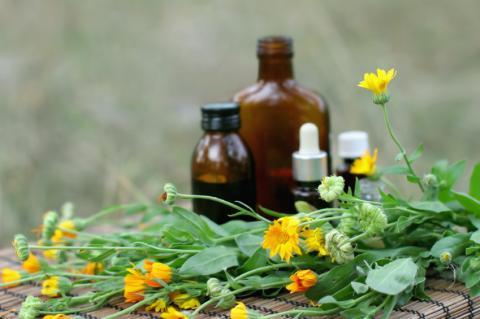
Tinctures are a wonderful addition to the household medicine cabinet. A tincture is a concentrated liquid herbal extract. Tinctures are really easy to make and highly effective. They are made using consumable alcohol and medicinal plants, herbs, roots, berries, or bark. For those of you who do not use alcohol, a similar product can be made using apple cider vinegar, vegetable glycerin, honey, or white vinegar. When making the recipe without alcohol, it is called an extract.
The type of alcohol used in the tincture is up to whoever is making it, as long as it is at least 80 proof or higher. Vodka is commonly used, as is rum. I particularly like to make mine using a spiced rum, especially for things like a cough and cold. Grain alcohol, such as Everclear, is a great alcohol to use because it is 190 proof, the highest you can get. Unfortunately for medicine makers, Everclear is not legally available everywhere. The alcohol serves as a preservative, bringing the shelf-life from several months to possibly years, although the longer the tincture sits, the less potent it typically becomes. However, one medicine woman told me some can last indefinitely, due to the alcohol, and remain just as potent.
Tinctures can be made using fresh or dried flowers, leaves, roots, barks, and berries from various medicinal plants and herbs. There are certain combinations of herbs and alcohol that work better for various reasons.
Here is some information on plant & alcohol combinations:
- 90 Proof Vodka is best used with dried herbs; you can use fresh herbs too as long as they aren't too moist or juicy.
- A half and half combination of 80 Proof Vodka and 190 Proof Grain Alcohol is amazing for extracting the volatile aromatic properties. It is better used with high moisture herbs, berries, and aromatic roots.
- 190 Proof Grain Alcohol is used to dissolve gums and resins, as well as extracting aromatics and essential oils.
The higher the alcohol proof and percentage, the better it is to draw out all of the medicinal properties contained in the juices and plant matter.
Proper Plant Preparation
Every maker of medicine and every healer does things in their own way. Some herbalists like to leave the flowers and leaves whole in their tinctures while others prefer to process them in one way or another. Sometimes I like to do a little of both, especially if I am leaving the tincture in a jar instead of a dropper (simply because it looks so beautiful).
When using fresh leaves, flowers, roots, bark, or herbs, it is best to chop or grind them in order to release all of the fresh juices and oils. When using dry ingredients, just be sure they are finely cut. The measurements vary depending on the plant material you are using.
Fresh Leaves & Flowers = Fill the jar 2/3 to ¾ of the way full.
Dried Leaves & Flowers = Fill the jar ½ to ¾ of the way full.
Fresh Roots, Berries, Barks = Fill the jar 1/3 to ½ of the way full.
Dried Roots, Berries, Barks = Fill the jar ¼ to 1/3 of the way full. Dried roots, berries, and bark will expand when they are reconstituted to 1½ of their size so that is why there is so little added to the jars.
Instructions
There are a couple of different methods used for making a tincture. I will explain the different ways to make a tincture, as well as how to make an extra strength double extraction. All of the supplies remain the same.
Supplies & Ingredients
Pint-sized glass jar with a lid
Consumable alcohol
Herbs/plants
Cheese cloth
Process #1 - Loosely fill your jar with the appropriate amount of herbs or plant material. Pour in your alcohol to the top and stir. Cover with a lid and leave it in a cool dark place for the next 6-8 weeks, shaking at least once daily to help the medicinal properties escape and to assure all of the plant matter is submerged. When the time is up, use the cheese cloth to strain the tincture, discard the herbs to the compost, and pour the medicine into a dark colored dropper bottle.
Process #2 – Use a cheese cloth to make an herb bundle using a string to tie it off at the top. Place the bundle into your jar and fill with alcohol. The rest of the instructions are the same as process 1; it is simply easier to pull out the herb bundle and squeeze than it is to use the normal straining method.
Process #3 – Loosely fill your jar with plants/herbs just as above. Take freshly boiled water and pour enough over the plants just to completely moisten them. This process is believed to help draw out all of the beneficial properties of the plant. Let it sit for about 3 minutes and fill the jar the rest of the way full with alcohol. The rest of the process remains the same as that in #1 with storing, shaking, and straining.
Extra Strength Double Extraction – The whole process is the same until it comes to straining. After you strain off your tincture you are going to add a second batch of herbs/plants, topping it off with a little more alcohol. Let this sit for another 3 weeks, shaking it everyday. Strain and store.
Labeling
It is good practice to label all of your medicines properly. Here are a few things to be sure to add:
- Plants: common and Latin name.
- Parts used.
- Fresh or dried
- The date it was made & bottled off.
- Dosages.
- Alcohol percentage. I also like to add what type of alcohol is used.
So the final important piece of information needed is the dosage. For my personal use, when it comes to dosage, adults take ½ to 1 teaspoon of tincture three times daily, for about two weeks. Children take a dose of ¼ to 1/3 of an adult dose. YES, there is a little math. If you purchase your tinctures instead of making them at home, there is usually proper dosage information provided.
Some of my personal favorite tinctures:
Usnea & Spiced Rum: This tincture is great for combating strep throat, tonsillitis, cough & colds, and many other things. It is an antibiotic tincture that I will be covering in an article a little later.
Lemon Balm / Valerian & Rum: Great for anxiety.
California Poppy & Grain Alcohol: This tincture is used for insomnia, restlessness, and anxiety.
Anise Seed/Catnip/Chamomile & Spiced Rum: This tincture is good for tummy aches. Not only is it soothing, but it will also clear up the issues pretty quickly.
I may not be a medical doctor but I have been making and using tinctures for over 5 years now. Just like with any other medicines, some things will work for some while they may not for others. What I love about tinctures is that there are so many combinations for so many ailments -- not to mention how much safer they can be with fewer side effects.
Photo Credit: "Calendula Flower Essential Oil and Tincture" by Kim Almonla is licensed under CC BY 2.0








